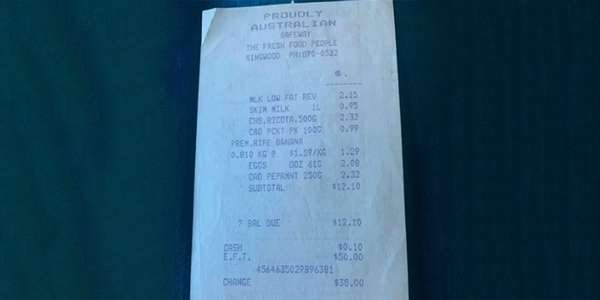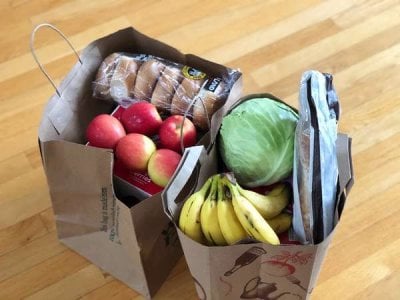The Surprising Detail In A 31-Year-Old Receipt That Has Supermarket Shoppers In Awe!
Looking back in time, one can't help but notice how the cost of groceries was noticeably lower, evoking a sense of nostalgia for a time when budgets stretched further, and shopping felt more affordable.
A receipt from 1992, shared on social media, has shoppers staring in bewilderment as they caught a glimpse of the price tags on fresh food items 31 years ago.

Just imagine, $12.10 could get you a basket full of goodies from Safeway—now Woolworths—offering a stark contrast to the $27 we'd part ways with for the same items today.
The differences are quite startling! For instance, a litre of low-fat milk was just $2.15, while a satisfying 250g block of Cadbury's chocolate came in at a mere $2.32.
Fast-forward to today, you'll be forking out $5 for your minty indulgence at Woolies—more than double what it once was.
One commented on the post saying, ‘Back when a dozen eggs were a cheeky two bucks!’
Speaking of prices, while they've certainly inflated over the years, it's important to note that Australian wages have also experienced a surge.
This cost difference has led to discussions about whether Australians are genuinely worse off today, considering that grocery prices have roughly doubled over the years while Australian wages have tripled during the same period.
These contrasting trends prompt reflection on the complex relationship between the cost of living, wage growth, and the changing economic landscape over time.

One user argued, ‘For 31 years ago, prices on those items haven't gone up too much.’
They added, ‘So chocolate is the same price, almost. I mean, you can get a whole block for $2, but bananas and eggs have gone up 300%+.’
Another commented, ‘Society is going so backwards. Unhealthy food is becoming cheaper and easier to get; healthy food is becoming more expensive and harder to get.’
Despite some indications of a potential easing of the cost-of-living crisis, many Australians continue to face difficulties managing their household budgets to meet essential needs.
Notably, food and beverage costs have experienced a significant increase of 7.9 per cent in the 12 months leading up to May 2023.
Michelle Marquardt, Head of Prices and Statistics at the Australian Bureau of Statistics (ABS), shed light on this alarming trend.
She said, 'The main contributor to this increase was meals out and takeaway food as higher costs of ingredients, utilities, and wages are passed on.'

After comparing grocery prices from 1992 to today, what are your thoughts on the changing cost of living and its impact on household budgets?
Do you believe Australians are worse off today?
A receipt from 1992, shared on social media, has shoppers staring in bewilderment as they caught a glimpse of the price tags on fresh food items 31 years ago.

A receipt from Safeway supermarket, dated November 2, 1992, has sparked a conversation regarding the cost of groceries. Source: Reddit/Anuksukamon.
Just imagine, $12.10 could get you a basket full of goodies from Safeway—now Woolworths—offering a stark contrast to the $27 we'd part ways with for the same items today.
The differences are quite startling! For instance, a litre of low-fat milk was just $2.15, while a satisfying 250g block of Cadbury's chocolate came in at a mere $2.32.
Fast-forward to today, you'll be forking out $5 for your minty indulgence at Woolies—more than double what it once was.
One commented on the post saying, ‘Back when a dozen eggs were a cheeky two bucks!’
Speaking of prices, while they've certainly inflated over the years, it's important to note that Australian wages have also experienced a surge.
This cost difference has led to discussions about whether Australians are genuinely worse off today, considering that grocery prices have roughly doubled over the years while Australian wages have tripled during the same period.
These contrasting trends prompt reflection on the complex relationship between the cost of living, wage growth, and the changing economic landscape over time.

The comparison of grocery prices between the past and present highlights the significant changes in the cost of essential items over time. Photo by Maria Lin Kim on Unsplash
One user argued, ‘For 31 years ago, prices on those items haven't gone up too much.’
They added, ‘So chocolate is the same price, almost. I mean, you can get a whole block for $2, but bananas and eggs have gone up 300%+.’
Another commented, ‘Society is going so backwards. Unhealthy food is becoming cheaper and easier to get; healthy food is becoming more expensive and harder to get.’
Despite some indications of a potential easing of the cost-of-living crisis, many Australians continue to face difficulties managing their household budgets to meet essential needs.
Notably, food and beverage costs have experienced a significant increase of 7.9 per cent in the 12 months leading up to May 2023.
Michelle Marquardt, Head of Prices and Statistics at the Australian Bureau of Statistics (ABS), shed light on this alarming trend.
She said, 'The main contributor to this increase was meals out and takeaway food as higher costs of ingredients, utilities, and wages are passed on.'
Key Takeaways
- A supermarket receipt from 1992 has resurfaced online, presenting a comparison between grocery prices then and now.
- Social media users debate whether Australians are worse off today by comparing the cost of goods in 1992 with today's prices.
- The cost of each item on the list has significantly increased over the past three decades, with the same small shop costing over $27 today.
- The Australian Bureau of Statistics notes that the cost of food and beverages rose by 7.9 per cent in the 12 months to May 2023, particularly impacting meals out and takeaway food.
After comparing grocery prices from 1992 to today, what are your thoughts on the changing cost of living and its impact on household budgets?
Do you believe Australians are worse off today?







